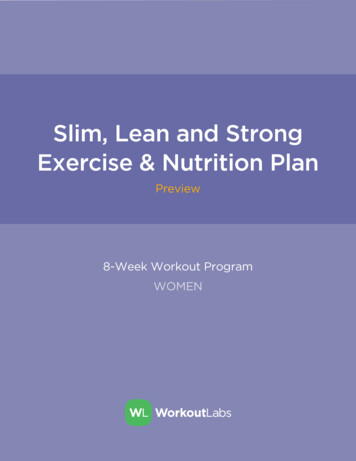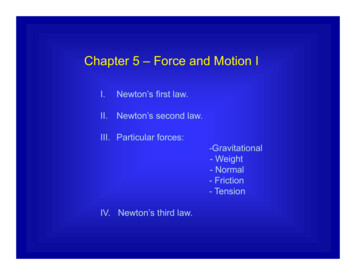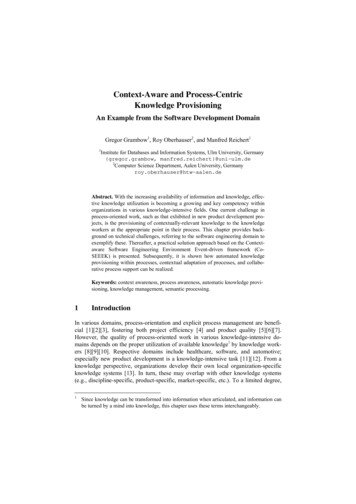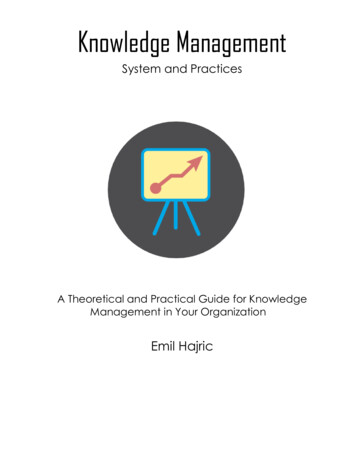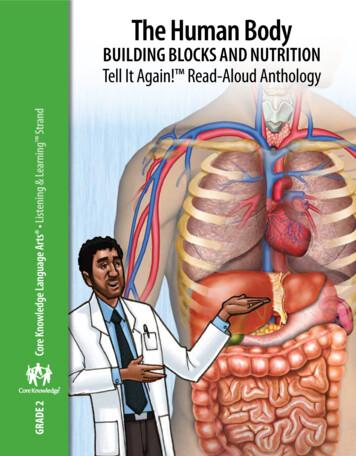
Transcription
The Human BodyGrade 2Core Knowledge Language Arts Listening & Learning StrandBuilding Blocks and NutritionTell It Again! Read-Aloud Anthology
The Human BodyBuilding Blocks and NutritionTell It Again! Read-Aloud AnthologyListening & Learning StrandGrade 2Core Knowledge Language Arts
Creative Commons LicensingThis work is licensed under a Creative Commons AttributionNonCommercial-ShareAlike 3.0 Unported License.You are free:to Share — to copy, distribute and transmit the workto Remix — to adapt the workUnder the following conditions:Attribution — You must attribute the work in thefollowing manner:This work is based on an original work of the CoreKnowledge Foundation made available throughlicensing under a Creative Commons AttributionNonCommercial-ShareAlike 3.0 Unported License. Thisdoes not in any way imply that the Core KnowledgeFoundation endorses this work.Noncommercial — You may not use this work forcommercial purposes.Share Alike — If you alter, transform, or build upon thiswork, you may distribute the resulting work only underthe same or similar license to this one.With the understanding that:For any reuse or distribution, you must make clear toothers the license terms of this work. The best way todo this is with a link to this web 3.0/Copyright 2013 Core Knowledge Foundationwww.coreknowledge.orgAll Rights Reserved.Core Knowledge Language Arts, Listening & Learning,and Tell It Again! are trademarks of the Core KnowledgeFoundation.Trademarks and trade names are shown in this book strictlyfor illustrative and educational purposes and are the propertyof their respective owners. References herein should notbe regarded as affecting the validity of said trademarks andtrade names.
Table of ContentsThe Human BodyBUILDING BLOCKS AND NUTRITIONTell It Again! Read-Aloud AnthologyAlignment Chart for The Human Body: Building Blocks and Nutrition. . . . . . . . . . . . . . . . . . . . . . . . . . . . . . . . . .vIntroduction to The Human Body: Building Blocks and Nutrition . . . . . . . . . . . . . . . . . . . . . . . . . . . . . . . . . . .1Lesson 1: The Amazing Human Body . . . . . . . . . . . . . . . . . . . . . . . . . . . . . . . . . . . . . . . . . . . . . . . . . . 12Lesson 2: Anton van Leeuwenhoek . . . . . . . . . . . . . . . . . . . . . . . . . . . . . . . . . . . . . . . . . . . . . . . . . . . 27Lesson 3: Cells and Tissues . . . . . . . . . . . . . . . . . . . . . . . . . . . . . . . . . . . . . . . . . . . . . . . . . . . . . . . . 39Lesson 4: Organs . . . . . . . . . . . . . . . . . . . . . . . . . . . . . . . . . . . . . . . . . . . . . . . . . . . . . . . . . . . . . . 52Pausing Point . . . . . . . . . . . . . . . . . . . . . . . . . . . . . . . . . . . . . . . . . . . . . . . . . . . . . . . . . . . . . . . 65Lesson 5: The Digestive System . . . . . . . . . . . . . . . . . . . . . . . . . . . . . . . . . . . . . . . . . . . . . . . . . . . . . 69Lesson 6: The Excretory System . . . . . . . . . . . . . . . . . . . . . . . . . . . . . . . . . . . . . . . . . . . . . . . . . . . . . 80Lesson 7: Nutrients . . . . . . . . . . . . . . . . . . . . . . . . . . . . . . . . . . . . . . . . . . . . . . . . . . . . . . . . . . . . 91Lesson 8: A Well-Balanced Diet . . . . . . . . . . . . . . . . . . . . . . . . . . . . . . . . . . . . . . . . . . . . . . . . . . . . 103Lesson 9: A Healthy Human Body . . . . . . . . . . . . . . . . . . . . . . . . . . . . . . . . . . . . . . . . . . . . . . . . . . . 115Domain Review . . . . . . . . . . . . . . . . . . . . . . . . . . . . . . . . . . . . . . . . . . . . . . . . . . . . . . . . . . . . . 127Domain Assessment. . . . . . . . . . . . . . . . . . . . . . . . . . . . . . . . . . . . . . . . . . . . . . . . . . . . . . . . . . 131Culminating Activities . . . . . . . . . . . . . . . . . . . . . . . . . . . . . . . . . . . . . . . . . . . . . . . . . . . . . . . . 135Appendix . . . . . . . . . . . . . . . . . . . . . . . . . . . . . . . . . . . . . . . . . . . . . . . . . . . . . . . . . . . . . . . . . 137
Alignment Chart for The Human Body: Building Blocks and NutritionThe following chart contains core content objectives addressed in thisdomain. It also demonstrates alignment between the Common CoreState Standards and corresponding Core Knowledge Language Arts(CKLA) goals.Alignment Chart for The Human Body: BuildingBlocks and NutritionLesson123456789Core Content ObjectivesIdentify the five senses and associated body parts Identify the skeletal, muscular, circulatory, nervous, digestive, andexcretory systems as important systems in the human body Describe the significant contributions of Anton van Leeuwenhoek Explain that all living things are made of microscopic cells Describe the relationship among cells, tissues, organs, andsystems Identify important components of the digestive system and theirfunctions Describe the process of nourishing the body from the time food istaken into the mouth until waste is removed from the body Identify important components of the excretory system and theirfunctions Describe how the digestive and excretory systems work together Explain the importance of vitamins and minerals to the body Explain the importance of eating a balanced diet Classify foods as healthy or unhealthy Plan a daily balanced diet The Human Body: Building Blocks and Nutrition Alignment Chart 2013 Core Knowledge Foundationv
Alignment Chart for The Human Body: BuildingBlocks and NutritionLesson123456789Reading Standards for Literature: Grade 2Key Ideas and DetailsSTD RI.2.1CKLAGoal(s)Ask and answer such questions as who, what, where, when, why, and how to demonstrate understanding ofkey details in a text.Ask and answer questions (e.g., who, what,where, when, why, how), orally or in writing,requiring literal recall and understanding of thedetails and/or facts of a nonfiction/informationalread-aloud Answer questions that require makinginterpretations, judgments, or giving opinionsabout what is heard in a nonfiction/informationalread-aloud, including answering why questionsthat require recognizing cause/effect relationships STD RI.2.3Describe the connection between a series of historical events, scientific ideas or concepts, or steps in technicalprocedures in a text.CKLAGoal(s)Describe the connection between a series ofhistorical events, scientific ideas or concepts,or steps in technical procedures in a nonfiction/informational read-aloud Craft and StructureSTD RI.2.4Determine the meaning of words and phrases in a text relevant to a Grade 2 topic or subject area.CKLAGoal(s)Determine the meaning of unknown words andphrases in nonfiction/informational read-aloudsand discussions Integration of Knowledge and IdeasSTD RI.2.7Explain how specific images (e.g., a diagram showing how a machine works) contribute to and clarify a text.CKLAGoal(s)Interpret information from diagrams, charts,timelines, graphs, or other organizers associatedwith a nonfiction/informational read-aloud andexplain how these graphics clarify the meaning ofthe read-aloudSTD RI.2.8Describe how reasons support specific points the author makes in a text.CKLAGoal(s)Describe how reasons or facts support specificpoints the author makes in a nonfiction/informational read-aloudSTD RI.2.9Compare and contrast the most important points presented by two texts on the same topic.CKLAGoal(s)Compare and contrast (orally or in writing)similarities and differences within a singlenonfiction/informational read-aloud or betweentwo or more nonfiction/informational read-aloudsvi The Human Body: Building Blocks and Nutrition Alignment Chart 2013 Core Knowledge Foundation
Alignment Chart for The Human Body: BuildingBlocks and NutritionLesson123456789Range of Reading and Level of Text ComplexitySTD RI.2.10By the end of year, read and comprehend informational texts, including history/social studies, science, andtechnical texts, in the Grades 2–3 text complexity band proficiently, with scaffolding as needed at the high endof the range.CKLAGoal(s)Listen to and demonstrate understandingof nonfiction/informational read-alouds ofappropriate complexity for Grades 2–4 Writing Standards: Grade 2Research to Build and Present KnowledgeSTD W.2.8CKLAGoal(s)Recall information from experiences or gather information from provided sources to answer a question.Make personal connections (orally or inwriting) to events or experiences in a fiction ornonfiction/informational read-aloud and/or makeconnections among several read-alouds With assistance, categorize and organize factsand information within a given domain to answerquestions Speaking and Listening Standards: Grade 2Comprehension and CollaborationSTD SL.2.1Participate in collaborative conversations with diverse partners about Grade 2 topics and texts with peers andadults in small and large groups.STD SL.2.1aFollow agreed-upon rules for discussions (e.g., gaining the floor in respectful ways, listening to others with care,speaking one at a time about the topics and texts under discussion).CKLAGoal(s)Use agreed-upon rules for group discussions,e.g., look at and listen to the speaker, raisehand to speak, take turns, say “excuse me” or“please,” etc.STD SL.2.1bBuild on others’ talk in conversations by linking their comments to the remarks of others.CKLAGoal(s)Carry on and participate in a conversation overat least six turns, staying on topic, linking theircomments to the remarks of others, with eitheran adult or another child of the same ageSTD SL.2.1cAsk for clarification and further explanation as needed about the topics and texts under discussion.CKLAGoal(s)Ask questions to clarify information about thetopic in a fiction or nonfiction/informational readaloud The Human Body: Building Blocks and Nutrition Alignment Chart 2013 Core Knowledge Foundationvii
Alignment Chart for The Human Body: BuildingBlocks and NutritionLesson123456789Presentation of Knowledge and IdeasSTD SL.2.4Tell a story or recount an experience with appropriate facts and relevant, descriptive details, speaking audibly incoherent sentences.CKLAGoal(s)Recount a personal experience with appropriatefacts and relevant, descriptive details, speakingaudibly in coherent sentencesSTD SL.2.5Create audio recordings of stories or poems; add drawings or other visual displays to stories or recounts ofexperiences when appropriate to clarify ideas, thoughts, and feelings.CKLAGoal(s)Create audio recordings of stories or poems;add drawings or other visual displays to storiesor recounts of experiences when appropriate toclarify ideas, thoughts, and feelingsSTD SL.2.6Produce complete sentences when appropriate to task and situation in order to provide requested detail orclarification. (See Grade 2 Language.)CKLAGoal(s)Produce complete sentences when appropriateto task and situation in order to providerequested detail or clarification Language Standards: Grade 2Vocabulary Acquisition and UseSTD L.2.4Determine or clarify the meaning of unknown and multiple-meaning words and phrases based on Grade 2reading and context, choosing flexibly from an array of strategies.STD L.2.4bDetermine the meaning of the new word formed when a known prefix is added to a known word (e.g., happy/unhappy, tell/retell).CKLAGoal(s)Use word parts to determine meaningsof unknown words in fiction or nonfiction/informational read-alouds and discussionsSTD L.2.5Demonstrate understanding of word relationships and nuances in word meanings.STD L.2.5aIdentify real-life connections between words and their use (e.g., describe foods that are spicy or juicy). Identify real-life connections between words andtheir use (e.g., describe foods that are spicy orjuicy)CKLAGoal(s)viiiDetermine the meaning of unknown andmultiple meaning words and phrases in fictionor nonfiction/informational read-alouds anddiscussionsThe Human Body: Building Blocks and Nutrition Alignment Chart 2013 Core Knowledge Foundation
Alignment Chart for The Human Body: BuildingBlocks and NutritionSTD L.2.6123456789Use words and phrases acquired through conversations, reading and being read to, and responding to texts,including using adjectives and adverbs to describe (e.g., When other kids are happy that makes me happy).Learn the meaning of common sayings andphrasesCKLAGoal(s)LessonUse words and phrases acquired throughconversations, reading and being read to, andresponding to texts, including using adjectivesand adverbs to describe (e.g., When other kidsare happy that makes me happy) Additional CKLA GoalsPrior to listening to a read-aloud, identify (orally or in writing) whatthey know and have learned that may be related to the specificstory or topic to be read aloudSequence five pictures illustrating the digestive process These goals are addressed in all lessons in this domain. Rather than repeat these goals as lessonobjectives throughout the domain, they are designated here as frequently occurring goals.The Human Body: Building Blocks and Nutrition Alignment Chart 2013 Core Knowledge Foundationix
Introduction to The Human Body:Building Blocks and NutritionThis introduction includes the necessary background information tobe used in teaching The Human Body: Building Blocks and Nutritiondomain. The Tell It Again! Read-Aloud Anthology for The Human Body:Building Blocks and Nutrition contains nine daily lessons, each of whichis composed of two distinct parts, so that the lesson may be dividedinto smaller chunks of time and presented at different intervals duringthe day. Each entire lesson will require a total of sixty minutes.This domain includes a Pausing Point after Lesson 4 when studentshave covered the topic of organs. At the end of the domain, a DomainReview, a Domain Assessment, and Culminating Activities are includedto allow time to review, reinforce, assess, and remediate contentknowledge. You should spend no more than thirteen days totalon this domain.Week One#Day 3#Day 4# #Day 1Day 2Lesson 1A: “The AmazingHuman Body” (40 min.)Lesson 2A: “Anton vanLeeuwenhoek” (40 min.)Lesson 3A: “Cells andTissues” (40 min.)Lesson 4A: “Organs”(40 min.)Lesson 1B: Extensions(20 min.)Lesson 2B: Extensions(20 min.)Lesson 3B: Extensions(20 min.)Lesson 4B: Extensions(20 min.)60 min.60 min.60 min.60 min.Day 7Day 8Day 9Lesson 5A: “TheDigestive System”(40 min.)Lesson 6A: “TheExcretory System”(40 min.)Lesson 7A: “Nutrients”(40 min.)Lesson 8A: “A WellBalanced Diet” (40 min.)Lesson 9A: “A HealthyHuman Body” (40 min.)Lesson 5B: Extensions(20 min.)Lesson 6B: Extensions(20 min.)Lesson 7B: Extensions(20 min.)Lesson 8B: Extensions(20 min.)Lesson 9B: Extensions(20 min.)60 min.60 min.60 min.60 min.60 min.Day 5Pausing Point (60 min.)60 min.Week TwoDay 6##Day 10Week ThreeDay 11#Day 12 Day 13Domain Review (60 min.)Domain Assessment(60 min.)Culminating Activities(60 min.)60 min.60 min.60 min.# Lessons include Student Performance Task Assessments# Lessons require advance preparation and/or additional materials; please plan aheadThe Human Body: Building Blocks and Nutrition Introduction 2013 Core Knowledge Foundation1
Domain ComponentsAlong with this anthology, you will need: Tell It Again! Media Disk or the Tell It Again! Flip Book* for TheHuman Body: Building Blocks and Nutrition Tell It Again! Image Cards for The Human Body: Building Blocksand Nutrition Tell It Again! Supplemental Guide for The Human Body: BuildingBlocks and Nutrition*The Tell It Again! Posters and Multiple Meaning Word Posters forThe Human Body: Building Blocks and Nutrition are found at theend of the Tell It Again! Flip Book.Recommended Resource: Core Knowledge Grade 2 Teacher Handbook, edited byE. D. Hirsch, Jr. and Souzanne A. Wright (Core KnowledgeFoundation, 2005) ISBN 978-1890517748Why The Human Body: Building Blocks and Nutrition is ImportantThis domain covers a number of topics regarding the human body.This domain first covers concepts regarding cells and how cellsform the building blocks of life on Earth. Students are then taughthow collections of cells form tissues, and tissues form organs, andfinally how organs work within the various body systems. In addition,students are taught about Anton van Leeuwenhoek and his work withthe microscope and his discovery of the tiny one-celled bacteria.Students will then hear about the digestive and excretory systems.They will learn the fundamental parts and functions of these twobody systems. The narrator of these read-alouds is a nutritionistnamed Nick Nutri, who reinforces basic facts that students will belearning.The remainder of this domain focuses on the importance of goodnutrition and how to make good choices in order to eat a wellbalanced diet. Students will be taught five keys to good health—eat well, exercise, sleep, keep clean, and have regular checkups.2The Human Body: Building Blocks and Nutrition Introduction 2013 Core Knowledge Foundation
What Students Have Already Learned in Core KnowledgeLanguage Arts During Kindergarten and Grade 1The following domains, and the specific core content that wastargeted in those domains, are particularly relevant to the readalouds students will hear in The Human Body: Building Blocksand Nutrition. This background knowledge will greatly enhancestudents’ understanding of the read-alouds they are about toenjoy:The Five Senses (Kindergarten) Identify and describe the five senses: sight, hearing, smell, taste,and touch Identify the body parts associated with the five senses Provide simple explanations about how the eyes, ears, nose,tongue, and skin work Describe how the five senses help people learn about their world Describe some ways the five senses help protect people fromharm Describe ways people take care of their bodies and protectthem from harm Describe the experiences and challenges of someone who isblind or deafThe Human Body (Grade 1) Explain that the human body is a network of systems Identify the skeletal, muscular, digestive, circulatory, andnervous systems Recall basic facts about the skeletal, muscular, digestive,circulatory, and nervous systems Identify the heart as a muscle that never stops working Explain the importance of exercise and a balanced diet forbodily health Identify the brain as the body’s control center Explain that germs can cause disease in the bodyThe Human Body: Building Blocks and Nutrition Introduction 2013 Core Knowledge Foundation3
Identify Edward Jenner as the man who developed the firstvaccine Identify Louis Pasteur as the man who discovered pasteurization Explain the importance of exercise, cleanliness, a balanced diet,and rest for bodily health Explain the importance of regular checkups Explain how vaccinations can prevent disease Explain that the food pyramid is one way to depict a balanceddiet Identify the component food groups in a balanced diet4The Human Body: Building Blocks and Nutrition Introduction 2013 Core Knowledge Foundation
Core Vocabulary for The Human Body: Building Blocks and NutritionThe following list contains all of the core vocabulary words in TheHuman Body: Building Blocks and Nutrition in the forms in whichthey appear in the domain. These words appear in the read-aloudsor, in some instances, in the “Introducing the Read-Aloud” sectionat the beginning of the lesson. Boldfaced words in the list havean associated Word Work activity. The inclusion of the words onthis list does not mean that students are immediately expected tobe able to use all of these words on their own. However, throughrepeated exposure throughout all lessons, they should acquirea good understanding of most of these words and begin to usesome of them in conversation.Lesson 1Lesson 4Lesson stemstransplantproteinsvaccinationsLesson 5Lesson 8Lesson lanced dietobservationsLesson 6Lesson 9Lesson petissueThe Human Body: Building Blocks and Nutrition Introduction 2013 Core Knowledge Foundation5
Comprehension QuestionsIn the Tell It Again! Read-Aloud Anthology for The HumanBody: Building Blocks and Nutrition, there are three types ofcomprehension questions. Literal questions assess students’recall of key details from the read-aloud; these questions are textdependent, requiring students to paraphrase and/or refer back tothe portion of the read-aloud in which the specific answer to thequestion is provided. These questions generally address ReadingStandards for Literature 1 (RL.2.1) and Reading Standards forInformational Text 1 (RI.2.1).Inferential questions ask students to infer information from the textand think critically; these questions are also text dependent, butrequire students to paraphrase and/or refer back to the differentportions of the read-aloud that provide information leading toand supporting the inference they are making. These questionsgenerally address Reading Standards for Literature 2 through 5(RL.2.2–RL.2.5) and Reading Standards for Informational Text 2through 4, and 6 (RI.2.2–RI.2.4; RI.2.6).Evaluative questions ask students to build upon what they havelearned from the text using analytical and application skills;these questions are also text dependent, but require students toparaphrase and/or refer back to the portion(s) of the read-aloudthat substantiate the argument they are making or the opinion theyare offering. Evaluative questions might ask students to describehow reasons or facts support specific points in a read-aloud,which addresses Reading Standards for Informational Text 8(RI.2.8). Evaluative questions might also ask students to compareand contrast information presented within a read-aloud or betweentwo or more read-alouds, addressing Reading Standards forLiterature 9 (RL.2.9) and Reading Standards for Informational Text9 (RI.2.9).The Tell It Again! Read-Aloud Anthologies include complex texts, thuspreparing students in these early years for the increased vocabularyand syntax demands aligned texts will present in later grades. Asall of the readings incorporate a variety of illustrations, ReadingStandards for Literature 7 (RL.2.7) and Reading Standards forInformational Text 7 (RI.2.7) are addressed as well.6The Human Body: Building Blocks and Nutrition Introduction 2013 Core Knowledge Foundation
Student Performance Task AssessmentsIn the Tell It Again! Read-Aloud Anthology for The Human Body:Building Blocks and Nutrition, there are numerous opportunities toassess students’ learning. These assessment opportunities rangefrom informal observations, such as Think Pair Share and someExtension activities, to more formal written assessments. TheseStudent Performance Task Assessments (SPTA) are identified inthe Tell It Again! Read-Aloud Anthology with this icon: . Thereis also an end-of-domain summative assessment. Use the TensConversion Chart located in the Appendix to convert a raw scoreon each SPTA into a Tens score. On the same page, you will alsofind the rubric for recording observational Tens scores.Above and BeyondIn the Tell It Again! Read-Aloud Anthology for The Human Body:Building Blocks and Nutrition, there are numerous opportunitiesin the lessons and the Pausing Point to challenge students whoare ready to attempt activities that are above grade-level. Theseactivities are labeled “Above and Beyond” and are identified withthis icon: .Supplemental GuideAccompanying the Tell It Again! Read-Aloud Anthology is aSupplemental Guide designed specifically to assist educatorswho serve students with limited English oral language skills orstudents with limited home literary experience, which may includeEnglish Language Learners (ELLs) and children with special needs.Teachers whose students would benefit from enhanced orallanguage practice may opt to use the Supplemental Guide as theirprimary guide in the Listening & Learning Strand. Teachers mayalso choose to begin a domain by using the Supplemental Guideas their primary guide before transitioning to the Tell It Again!Read-Aloud Anthology, or may choose individual activities fromthe Supplemental Guide to augment the content covered in the TellIt Again! Read-Aloud Anthology.The Supplemental Guide activities that may be particularly relevantto any classroom are the Multiple Meaning Word Activities andThe Human Body: Building Blocks and Nutrition Introduction 2013 Core Knowledge Foundation7
accompanying Multiple Meaning Word Posters, which helpstudents determine and clarify different meanings of words;Syntactic Awareness Activities, which call students’ attention tosentence structure, word order, and grammar; and VocabularyInstructional Activities, which place importance on buildingstudents’ general academic, or Tier 2, vocabulary. These activitiesafford all students additional opportunities to acquire a richerunderstanding of the English language. Several of these activitieshave been included as Extensions in the Tell It Again! Read-AloudAnthology. In addition, several words in the Tell It Again! ReadAloud Anthology are underlined, indicating that they are multiplemeaning words. The accompanying sidebars explain some of themore common alternate meanings of these words. SupplementalGuide activities included in the Tell It Again! Read-Aloud Anthologyare identified with this icon: .Recommended Resources forThe Human Body: Building Blocks and NutritionTrade Book ListThe Tell It Again! Read-Aloud Anthology includes a number ofopportunities in Extensions, Pausing Point, and the CulminatingActivities for teachers to select trade books from this list toreinforce domain concepts through the use of authentic literature.In addition, teachers should consider other times throughout theday when they might infuse authentic, domain-related literature.If you recommend that families read aloud with their child eachnight, you may wish to suggest that they choose titles from thistrade book list to reinforce the domain concepts. You might alsoconsider creating a classroom lending library, allowing students toborrow domain-related books to read at home with their families.81.Bones: Our Skeletal System, by Seymour Simon(HarperCollins, 2000) ISBN 978-06881772182.The Bones Book and Skeleton, by Stephen Cumbaa (WorkmanPublishing Company, 2006) ISBN 978-07611421883.The Brain: Our Nervous System, by Seymour Simon(HarperCollins, 2006) ISBN 978-0060877194The Human Body: Building Blocks and Nutrition Introduction 2013 Core Knowledge Foundation
4.Cells, Tissues, and Organs, by Richard Spilsbury (HeinemannLibrary, 2008) ISBN 978-14329090485.The Digestive System, by Rebecca L. Johnson (LernerPublications Company, 2005) ISBN 978-08225124796.The Digestive System, by Kirstin Petrie MS, RD (ABDOPublishing Company, 2007) ISBN 978-1596797107.The Digestive System, by Christine Taylor-Butler (ScholasticInc., 2008) ISBN 978-05312073148.Dinosaurs Alive and Well!: A Guide to Good Health, by MarcBrown and Laurie Krasny Brown (Little, Brown Books forYoung Readers, 1992) ISBN 978-03161100999.The Dynamic Digestive System: How Does My StomachWork?, by John Burnstein (Crabtree Publishing Company,2009) ISBN 978-077874429010. The Edible Pyramid: Good Eating Every Day, by Loreen Leedy(Holiday House, 1994) ISBN 978-082342074211. Food and Digestion, by Andrew Solway (Sea-to-SeaPublications, 2011) ISBN 978-159771264412. Good Enough to Eat: A Kid’s Guide to Food and Nutrition, byLizzy Rockwell (HarperCollins, 2009) ISBN 978-006445174113. Greg’s Microscope, by Millicent E. Selsam, illustrated byArnold Lobel (HarperCollins, 1990) ISBN 978-006444144514. Gurgles and Growls: Learning About Your Stomach, byPamela Hill Nettleton (Picture Window Books, 2004) ISBN978-140480504015. Guts: Our Digestive System, by Seymour Simon (HarperCollinsPublishers, 2005) ISBN 978-006054651916. The Human Body, by Seymour Simon (Collins, 2008) ISBN978-006055541217. The Magic School Bus: Inside the Human Body, by JoannaCole, illustrated by Bruce Degen (Scholastic Audio Books,2011) ISBN 978-054524083318. Muscles: Our Muscular System, by Seymour Simon(HarperCollins, 2000) ISBN 978-0688177201The Human Body: Building Blocks and Nutrition Introduction 2013 Core Knowledge Foundation9
19. My Food Pyramid: Eat Right. Exercise. Have Fun., byAlisha Niehaus (Dorling Kindersley Limited, 2007) ISBN978-075662993920. My Organ Buddies, by Lee Downing and Felice Downing(Organ Buddies, Inc, 2010) ISBN 978-061532940621. Parts, by Tedd Arnold (Puffin, 2000) ISBN 978-014056533122. The Race Against Junk Food (Adventures in Good Nutrition),by Anthony Buono and Roy Nemerson (HCOM Inc., 1997)ISBN 978-096581080723. The Quest to Digest, by Mary K. Corcoran (Charlesbridge,2006) ISBN 978-157091664924. Ultra-Organized Cell Systems, by Rebecca L. Johnson(Millbrook Press, 2008) ISBN 978-082257138425. What Am I Made Of?, by David Bennett, illustrated by StuartTrotter (Aladdin Paperbacks, 1991) ISBN 978-068971490026. Where Does Your Food Go?, by Wiley Blevins (Scholastic Inc.,2003) ISBN 978-0516258607Websites and Other ResourcesStudent Resources1.How the Human Body Works (various systems)http://kidshealth.org/kid/htbw/htbw main page.html2.Human Body Systems 0/13/allsystems.swf3.I Know Thathttp://www.iknowthat.com/com/L3?Area Science%20Lab4.Mission Nutritionhttp://kidshealth.org/kid/games/mission nutrition.html#cat209185.A Ride Through the Human s2.htm6.Science Interactive teractives/3djigsaw 02/index.shtml?muscles10The Human Body: Building Blocks and Nutrition Introduction 2013 Core Knowledge Foundation
Teacher Resources7.Discovery Kids: Your Digestive dy-systems/your-
be used in teaching The Human Body: Building Blocks and Nutrition domain. The Tell It Again! Read-Aloud Anthology for The Human Body: Building Blocks and Nutrition contains nine daily lessons, each of which is composed of two distinct parts, so that the lesson may be divided into smaller c





